Audi UK has gone first with details of the new RS3 Sportback and it’s very good news too. Powered by the charismatic 2.5 litre inline five cylinder turbo engine the new RS3 pumps out 270kW (367PS) and 465Nm to all four wheels via its quattro all-wheel drive system. That’s a 20kW/15Nm increase over the previous-gen RS3.
Coupled to a 7-speed S tronic transmission the RS3 sprints to 100km/h in only 4.3 seconds. Sub 4.5 second 0–100 times in a family hatchback!
And that’s not the best news, either. No, the best news is, as first reported on AUSmotive back in October 2012, the RS3 will be offered for sale in Australia. Expect it to hit your local Audi dealer in late 2015.
Featuring the expected RS cosmetic enhancements the new RS3 looks great with its aggressive front grille and spoiler. Large oval-shaped exhaust tips set-off the back very nicely and perhaps the only disappointment is the new style 19″ alloy wheels.
For now we only have four images to work with, but no doubt more will be coming from Audi AG very soon. We’ll bring those to you when we can, along with all the detailed press material we can get our hands on.
UPDATE #1: Audi AG press release added below.
UPDATE #2: 13 new pics now available after the break.
New 367PS Audi RS 3 Sportback goes back to the future
12/12/14
Latest generation Audi high performance hatchback continues to honour classic Eighties quattros with highly evolved five-cylinder turbo power
- New flagship of the A3 model series available to order in the UK from March 2015 ahead of first customer deliveries next summer
- Most powerful production five-cylinder engine in Audi RS history with 367PS and 465Nm from 1,625rpm to 5,550rpm
- 0 – 62mph in 4.3 seconds – 0.3 seconds faster than the previous model – 155mph governed top speed can be raised to 174mph on request
- Lower weight, faster-shifting S tronic twin-clutch gearbox, faster-reacting quattro drive
When world-beating car meets class-conquering engine, the formidable result is the all new 367PS Audi RS 3 Sportback. The DNA for the world’s most powerful series production premium compact hatchback comes courtesy of the A3 hatchback – the 2014 World Car of the Year – and the latest evolution of the evocative 2.5-litre five-cylinder TFSI – the International Engine of the Year in the 2.0 to 2.5-litre category. Enhanced by latest generation quattro all-wheel-drive, these genes create a car with truly exceptional dynamic capabilities, but one which can also deftly handle everything that daily life throws at it.
“There is a long tradition of five-cylinder engines at Audi,†says Prof. Dr. Ulrich Hackenberg, Board Member for Technical Development at AUDI AG. “In the 80s, they turned Audi into a sporty brand, both in motor sports and in production. The new Audi RS 3 Sportback features the latest generation of our 2.5 litre, five-cylinder engine – the most powerful production engine in the modular transverse matrix.â€
Due to become available in the UK in March 2015, and expected to reach its first owners here next summer, the extreme high performance hatchback bolsters the 367PS output from its 2.5-litre TFSI with 465 Nm (343.0 lb-ft) of torque, which is available right from 1,625rpm through to 5,550rpm, enabling it to punch vigorously at the horizon in any gear and at virtually any speed.
Lighter, faster, more efficient
Helped by advances in construction processes and material use made as part of the Audi ultra efficiency programme, the successor to the original RS 3 Sportback weighs in 55kg lighter, tipping the scales at 1,520kg (without driver), despite additional equipment and safety features. Against the clock its resulting power-to-weight ratio of 241PS per ton helps it to clear the 62mph marker from rest in just 4.3 seconds, and to continue to an electronically governed 155mph top speed which, for drivers with regular Autobahn access, can be increased on request to 174mph.
The distinctive rhythm of the 1 – 2 – 4 – 5 – 3 five-cylinder ignition sequence – the classic Audi soundtrack played out since the 1980s by rally cars, touring cars and production models such as the Ur quattro, the RS 2 and the TT RS – washes over the cabin as the new RS 3 Sportback gathers momentum. Two flaps in the exhaust pipes control the exhaust flow to provide for an even more intensive sound experience that varies with engine load and speed, and the driver can control these flaps via the Audi drive select adaptive dynamics system, which is standard. For the first time in an Audi model at this level, the already fittingly bass-heavy RS exhaust system can be replaced at extra cost by an even richer-sounding sports exhaust upgrade.
In the latest edition of the classic engine increased power and torque goes hand in hand with improved efficiency, which is confirmed by its compliance with the latest EU6 emissions regulations. According to the NEDC consumption test the new ‘entry level’ RS model is capable of returning up to 34.8mpg, corresponding to CO2 emissions of 189g/km. A recuperation system, a demand-controlled oil pump and a newly developed start-stop system which turns off the engine shortly before the car comes to a stop contribute to this impressive data.
A seven-speed S tronic transmission, which has been reworked to offer even faster shifts, directs the power to the quattro permanent all-wheel drive system. The quattro system features torque vectoring based on intelligent software and is designed with maximum driving enjoyment foremost in mind. Its central component is an electronically controlled, hydraulically activated multi-plate clutch, the weight of which has been reduced by 1.4kg as further evidence of the adherence to the principles of Audi ultra throughout the car.
Variable quattro response
The clutch is mounted on the rear axle in the interest of balanced load distribution, and the parameters its bespoke RS 3 software works to can be controlled via the Audi drive select system. Depending on driving style and the coefficient of friction, it can send between 50 and 100 percent of the available torque to the rear axle, and when Audi drive select is in dynamic mode and the ESC Electronic Stabilisation Control system is in its sport setting, power is transferred to the rear sooner and in greater amounts for even greater agility and more direct turn-in. In this mode the driver can even perform controlled drifts on low-friction road surfaces. ESC can also be completely deactivated by pressing and holding the button.
The chassis of the five-door model also sets new standards. Compared with the Audi A3 Sportback, the body sits 25 millimetres lower, and the track of the McPherson front suspension has been widened to 1,559 millimetres. It incorporates specially developed, high-strength aluminium pivot bearings. The rear axle, which has a track width of 1,514 millimetres, is a four-link construction with rods of high-strength steel that handle the longitudinal and lateral forces separately.
The new progressive steering system is standard, and is capable of varying its ratio between 15.3:1 and 10.9:1 as a function of steering input. Its efficient, electromechanical servo boost has RS-specific settings.
The Audi magnetic ride adaptive damper system with its magnetorheological fluid-filled dampers that can be influenced by an electric current is available as an option. Its operating characteristics are adjustable via Audi drive select with its comfort, auto, dynamic and individual modes.
The internally ventilated disc brakes measure 370 millimetres in diameter at the front and 310 millimetres at the rear. The front friction rings feature a weight-saving wave design and are perforated for maximum heat dissipation. Pins connect them to aluminium brake caps, and they are gripped by eight-piston fixed calipers painted black (red optional) with RS logos.
Optional ceramic brakes
Among the technologies that differentiate the new Audi RS 3 Sportback from its competitors are the optional carbon fibre-ceramic brake discs on the front axle. They also measure 370 millimetres and are gripped by anthracite grey calipers.
The acclaimed framework within which all this advanced technology is integrated is the Volkswagen Group’s modular transverse matrix (MQB) with its strict lightweight construction concept. The occupant cell contains many components of ultra-high-strength and hot-shaped steels, and the bonnet is made of aluminium. The transverse orientation of the engine in combination with the multi-plate clutch and the battery, which are located in front of and behind the rear axle, respectively, contributes to a favourable axle load distribution.
The remarkable capabilities that render this car worthy of the RS badge are also visually referenced at the front of the car by the high-gloss black, honeycomb-look treatment for the Singleframe grille with its matt aluminium-look frame, by the pronounced air intake below the license plate frame and by the large side intakes framed by bold contours. The blade integrated into the front apron extends upward into the air intakes to form a vertical dividing bar.
Viewed in profile, the widened front wings, chiselled side sills, matt aluminium-look mirror housings and large roof spoiler immediately catch the eye, while at the rear the differentiation is clearly made by a remodelled bumper with high-gloss black diffuser insert, honeycomb grille and four bars, from which two large, oval tailpipes boldly protrude. Eight paint finishes will be available, including the two new shades Nardo grey and Catalunya red, metallic, the latter available exclusively for the RS 3 Sportback.
Dedicated individualists can order additional optional distinguishing features, including 19-inch matt titanium or high-gloss anthracite black machine polished alloy wheels as an alternative to the 19-inch five-arm rotor design fitted as standard, a carbon engine cover and styling packages in matt aluminium and gloss black which also include a quattro logo in titanium grey in the air inlet.
The purposeful black interior of the RS 3 Sportback also befits its status. Its sports seats are upholstered in Fine Nappa leather with contrasting stitching in rock grey, and the driver’s is perfectly positioned in relation to the flat-bottomed RS multifunction sports steering wheel with its leather and Alcantara trim. Stainless steel pedals, Alcantara door inserts and inlays in either 3D design black or optional Aluminium Race or Carbon also help to set the tone. High-quality applications in gloss anthracite black frame the instruments, which include black-faced dials with red needles and white scales, plus a driver‘s information system enhanced by a boost pressure indicator, an oil temperature gauge and a lap timer.
Lighter RS buckets seats
Standard equipment will of course be in keeping with this model’s ranking in the A3 line-up, as will the list of attractive options. For the first time in a compact class Audi this will include newly developed RS bucket seats with integrated side airbags and a carbon seat shell which are seven kilograms lighter than the standard sports seat. It will also offer an RS 3 interior design package with red accents on the seats, knee pads, air vents,floor mats and seat belts.
The infotainment and driver assistance systems familiar from the wider A3 range will naturally also be available, including MMI navigation plus with MMI touch and Audi connect bringing internet-based services to the car.
The new RS 3 Sportback takes the total number of RS models offered by quattro GmbH, the high-performance subsidiary responsible for developing and building the most extreme models in the Audi portfolio, to seven. The newcomer joins the RS Q3, RS 4 Avant, RS 5 Coupé and Cabriolet, RS 6 Avant and RS 7 Sportback.
Power in compact form – the new Audi RS 3 Sportback
- Sporty top model of the A3 model series
- Most powerful production five-cylinder in RS history with 270 kW (367 hp)
- 0 – 100 km/h (62.1 mph) in 4.3 seconds – 0.3 seconds faster than the previous model
Ingolstadt, 2014-12-12
Hot, throaty sound, exhilaratingly free-revving and brawny power – the five cylinder engines from Audi are legendary. 270 kW (367 hp) output and 465 Nm (343.0 lb ft) of torque – Audi presents the new RS 3 Sportback*, the most powerful compact car in the premium segment. With its powerful five cylinder, turbocharged engine, the five door model accelerates from 0 to 100 km/h (62.1 mph) in 4.3 seconds, and its top speed can be increased to 280 km/h (174.0 mph) upon request.
“There is a long tradition of five-cylinder engines at Audi,†says Prof. Dr. Ulrich Hackenberg, Board Member for Technical Development at AUDI AG. “In the 80s, they turned Audi into a sporty brand, both in motor sports and in production. The new Audi RS 3 Sportback features the latest generation of our 2.5 liter, five‑cylinder engine – the most powerful production engine in the modular transverse matrix.â€
The multiple award-winning 2.5 TFSI produces 270 kW (367 hp) and 465 Nm (343.0 lb‑ft) of torque in the new RS 3 Sportback. The turbocharged engine accelerates the compact five‑door from 0 to 100 km/h in 4.3 seconds, and top speed can be increased to 280 km/h (174.0 mph) upon request. In the NEDC, it consumes just 8.1 liters of fuel per 100 kilometers (29.0 US mpg), with CO2 emissions of 189 grams per kilometer (304.2 g/mi).
A seven-speed S tronic, which shifts even faster than in the previous model, directs the power of the 2.5 TFSI to the quattro permanent all‑wheel drive system. The quattro system features torque vectoring based on intelligent software and is designed through‑and‑through for maximum driving enjoyment. The new Audi RS 3 Sportback steers directly into corners. On low-friction road surfaces, drivers can even perform controlled drifts, if desired.
The chassis of the five‑door model also sets standards. Compared with the Audi A3 Sportback*, the body is 25 millimeters (1.0 in) lower. The pivot bearings of the front axle, the progressive steering, the RS‑specific sport suspension and optional Audi magnetic ride adaptive damper control are designed specifically for the RS. Audi mounts carbon fiber-ceramic brake discs behind the 19‑inch wheels on the front axle upon request – a first in the premium compact segment.
The Audi RS 3 Sportback complete package is rounded out with sharp interior and exterior details and a generous list of equipment. The new top model of the A3 family* is rolling into dealerships in summer 2015.
Power in compact form – the new Audi RS 3 Sportback
Audi presents the most powerful car in the premium compact segment: The new RS 3 Sportback produces 270 kW (367 hp) and delivers 465 Nm (343.0 lb-ft) of torque to the crankshaft. The 2.5 TFSI accelerates the five‑door model from 0 to 100 km/h (62.1 mph) in 4.3 seconds and goes on to reach an optional top speed of 280 km/h (174.0 mph).
Engine
The 2.5 TFSI in the new Audi RS 3 Sportback guarantees to thrill with immense pulling power, eager revving and its own unique acoustic experience. The throaty roar and snarl backed by the rhythm of the 1 – 2 – 4 – 5 – 3 five-cylinder ignition sequence is the classic Audi soundtrack. Two flaps in the exhaust pipes downstream of the muffler control the exhaust flow to provide for an even more intensive sound experience that varies with engine load and speed. The driver can control these flaps via the Audi drive select system. The RS exhaust system is designed for high flow. For the first time in this segment, Audi offers a sport exhaust system as an option.
Powerful five-cylinder engines have a long tradition at Audi. During the 1980s, they powered the Audi rally cars, touring cars and production models to the front of the pack. The first RS model, the RS 2 from 1994, also had such an engine. The five‑cylinder made its comeback in 2009 in the Audi TT RS; it made its way into the RS 3 Sportback in 2011 and two years later into the RS Q3*. The 2.5 liter engine has been voted “International Engine of the Year†in its class five years in a row since 2010.
The five-cylinder unit produces 270 kW (367 hp) from a displacement of 2,480 cc: a remarkable specific output of 108.9 kW (148.0 hp) per liter. Driveability is impressive. The peak torque of 465 Nm (343.0 lb-ft) is already available at 1,625 rpm and remains constant through 5,550 rpm. The sprint from 60 to 100 km/h (37.3 to 62.1 mph) in fourth gear takes just 4.1 seconds; it takes just 5.8 seconds to go from 80 to 120 km/h (49.7 to 74.6 mph) in fifth gear.
The 2.5 TFSI catapults the new Audi RS 3 Sportback to 100 km/h (62.1 mph) from a standing start in 4.3 seconds – the best in its class. Acceleration is electronically capped at 250 km/h (155.3 mph). Top speed can be optionally raised to 280 km/h (174.0 mph), which is also unique in the compact sports car segment. In the NEDC, the entry-level RS model consumes just 8.1 liters of fuel per 100 kilometers (29.0 mph), ten percent less than its predecessor. This corresponds to 189 grams CO2 per kilometer (304.2 g/mi). A recuperation system, a demand-controlled oil pump and a newly developed start-stop system that turns off the engine shortly before the car comes to a stop contribute to this. The emissions rating is Euro 6.
Just 49 centimeters (19.3 in) long, the five-cylinder is very short. It weighs approximately 180 kilograms (396.8 lb). Its crankcase is made of vermicular graphite cast iron, an extremely strong, yet lightweight material. Perfectly placed reinforcements enhance the block’s loadability. A small team of specially trained experts build the 2.5 TFSI by hand at the Audi engine plant in Győr, Hungary.
The turbocharger, which develops up to 1.3 bar of charge pressure, has a theoretical throughput of 1,100 kilograms (2,425.1 lb) of air per hour. The intercooler lowers the temperature of the compressed air. The interplay of turbocharging and direct injection enables a high 10.0:1 compression ratio and correspondingly good efficiency. Flaps in the intake manifold cause the inflowing air to rotate. The camshafts, each of which can be adjusted through 42 degrees of camshaft angle, further optimize the mixture.
Seven-speed S tronic
The standard seven-speed S tronic transfers the power of the 2.5 TFSI via three shafts – one drive shaft and two output shafts. Like all dual-clutch transmissions, it comprises two partial gearboxes. The direct shifting process takes place lightning-fast and with no perceptible interruption of power by simultaneously opening and closing both clutches. New detailed solutions for filling the clutches with oil and the interplay with the engine make gear changes faster than ever. With the Audi drive select system in dynamic mode, each shift is accompanied by double-clutching.
The driver of the new Audi RS 3 Sportback can choose between two automatic modes for the seven-speed S tronic or shift manually using the shift paddles on the steering wheel or the selector lever. The launch control system provides for optimal traction and minimal tire slip when sprinting from a standing start. The lower gears are sportily short; seventh gear is tall to reduce fuel consumption. A plug-connected angle drive connects the ultra-compact gearbox with the prop shaft – a design that displays intelligent lightweight construction down to the last detail.
quattro permanent all-wheel drive
The quattro permanent all-wheel drive system transfers the power of the 2.5 TFSI to the road with supreme ease. Its central component is the electronically controlled, hydraulically activated multi-plate clutch. The newly developed part is mounted at the rear axle for reasons of axle load distribution. The multi-plate clutch uses software custom tailored for the Audi RS 3 Sportback. It distributes the available torque as needed to the front and rear axles in the blink of an eye. Depending on the driving style and coefficient of friction, between 50 and 100 percent of the available torque can be sent to the rear axle.
The electric pump, which develops the necessary oil pressure of max. 38 bar, is highly efficient. It is activated immediately the instant road grip drops or the driver adopts a sportier style. The weight of the clutch was reduced by 1.4 kilograms (3.1 lb) versus the previous version by eliminating the pressure accumulator. Another example of targeted lightweight construction.
Control of the multi-plate clutch is integrated into the Audi drive select system. With its very sport configuration, it uses all handling-relevant information, such as the steering angle. In dynamic mode and when the ESC Electronic Stabilization Control system is set to sport mode, power is transferred sooner and in greater amounts to the rear axle for even better handling, giving the new Audi RS 3 Sportback very agile and direct turn-in. This enables the driver to even perform controlled drifts on low-friction road surfaces. The front axle pulls the car back onto a straight line when exiting a bend.
Torque vectoring makes the handling of the Audi RS 3 Sportback even more perfect. During fast cornering, it slightly brakes the interior wheels, which are under a reduced load. This enables both wheels on the axle to transfer more power to the road. Thanks to the difference in propulsive forces, the car turns slightly into the corner and supports the driver’s sporty driving style.
Chassis
The chassis complements the dynamics of the drivetrain perfectly. Precisely guided by its sensitive steering, the new Audi RS 3 Sportback takes all types of corners quickly and stably. Its handling limits are very high and effortlessly manageable.
The McPherson front suspension has been widened to a track of 1,559 millimeters (5.1 ft) and includes specially developed, high-strength aluminum pivot bearings. The standard progressive steering varies its ratio between 15.3:1 and 10.9:1 as a function of steering input. Its efficient, electromechanical servo boost works with an RS-typical characteristic.
The rear axle, which as a track width of 1,514 millimeters (5.0 ft), is a four-link construction with rods of high-strength steel that handle the longitudinal and lateral forces separately. As with the front axle, these forces are directed to a subframe. The taut RS sport suspension lowers the body by 25 millimeters (1.0 in) compared with the A3 Sportback. The Audi magnetic ride adaptive damper system is available as an option. Its management is integrated into the standard Audi drive select dynamic handling system, which includes the modes comfort, auto, dynamic and individual.
The dynamic, new top model of the A3 series rolls on 19-inch, cast aluminum wheels in five-arm rotor design with size 235/35 tires. Audi offers machine-polished 19-inch wheels in matt titanium look or high-gloss anthracite black. The top tire option includes size 255/30 tires up front and 235/35 at the rear.
The internally ventilated brake discs measure 370 millimeters (14.6 in) in diameter at the front and 310 millimeters (12.2 in) at the rear. The front friction rings feature a weight-saving wave design and are perforated for maximum heat dissipation. Pins connect them to aluminum brake caps, and they are gripped by eight-piston fixed calipers painted black (red optional) with RS logos.
One of the technologies that differentiate the new Audi RS 3 Sportback from its competitors are the optional carbon fiber-ceramic brake discs on the front axle. They also measure 370 millimeters (14.6 in) and are gripped by anthracite gray calipers. The Electronic Stabilization Control (ESC) offers a sport mode and can also be entirely deactivated with an extended push of a button.
Body and exterior design
The power-to-weight ratio plays a very key role in a sporty car. With the new Audi RS 3 Sportback, each hp has to move just 4.14 kilograms (9.1 lb). The practical five-door compact has a curb weight (without driver) of just 1,520 kilograms (3,351.0 lb), 55 kilograms (121.3 lb) less than its predecessor.
The basis for this top value is the Volkswagen Group’s modular transverse matrix (MQB) with its strict lightweight construction concept. The occupant cell contains many components of ultra-high-strength, hot-shaped steel, and the engine hood is made of aluminum. The orientation of the engine in combination with the multi-plate clutch and the battery, which are located in front of and behind the rear axle, respectively, contributes to a favorable axle load distribution.
The new top model in the A3 series reveals its potential at first glance. The Singleframe grille features a high-gloss black, honeycomb-look grille and a frame in matt aluminum look. The charge air flows in through the air inlet below the license plate frame. The large air inlets framed by bold contours provide air to the engine’s supplemental radiator and the transmission oil cooler. The blade integrated into the front apron extends upward into the air inlets to form a vertical dividing bar.
Viewed in profile, the widened front fenders, chiseled side sills, matt aluminum-look mirror housings and the large roof spoiler of the Audi RS 3 Sportback immediately catch the eye. A pronounced bumper, high-gloss black diffuser insert with honeycomb grille and four bars plus two large, oval tailpipes make for a bold rear. RS 3 badges adorn the Singleframe grille and the rear hatch.
Dedicated individualists can order additional features, including a carbon engine cover. The matt aluminum and gloss black styling packages are also particularly attractive. Besides exterior details with distinctive surface, they also include a quattro logo in titanium gray in the air inlet. The eight paint finishes include two new shades: Nardo gray and Catalunya red, metallic. The latter color is exclusive to the Audi RS 3 Sportback.
Interior and Equipment
The interior of the new Audi RS 3 Sportback is in sporty black and accentuated with RS badges. The sport seats are covered in Fine Nappa leather with contrasting stitching in rock gray. Wrapped in leather and Alcantara, the RS multifunction sport steering wheel is flattened at the bottom, and the selector lever also features a particularly sporty design. The driver information system includes a boost pressure indicator, an oil temperature gauge and a lap timer.
Fine details round out the atmosphere of dynamics and extraordinary craftsmanship. The pedals and footrest are made of stainless steel; the door trim inserts are Alcantara. As is typical for RS models, the door openers are slender double bars and the inlays are in 3D-design “Black†(optionally available in Aluminum Race or carbon). The dials in the RS instrument cluster are black, the needles red and the scales white. High-quality applications in gloss anthracite black frame the instruments.
Standard equipment in the new Audi RS 3 Sportback also includes the parking system plus and the MMI radio. Options include S sport seats with diamond pattern, embossed logos and optional light-colored upholstery, and for the first time in the compact segment the newly developed RS bucket seats with integrated side airbags and a carbon seat shell, which are seven kilograms (15.4 lb) lighter than the basic sport seat. Another attractive option is the RS 3 interior design package with red accents on the knee pad, the air vents, the floor mats and the seat belts. This color also shimmers through the perforations of the S sport seats.
The infotainment and driver assistance systems from the A3 series, including MMI navigation plus with MMI touch, are available without restriction in the new top model. The comfort and convenience package includes features such as power-adjustable and heated front seats, four-way lumbar supports, automatically dimming exterior mirrors and a light and rain sensor.
Deliveries of the powerful five-door model are scheduled to begin in summer 2015. The previous model was already a strong seller; Audi expects the new RS 3 Sportback to also be a great success. With this model, quattro GmbH, the high-performance subsidiary that develops and builds the sporty spearheads in the AUDI AG product portfolio, now has seven RS models on the market – The RS 3 Sportback, the RS Q3 and the RS 4 Avant* plus the RS 5 Coupé*, the RS 5 Cabriolet*, the RS 6 Avant* and the RS 7 Sportback*.
*Fuel consumption of the Audi RS 3 Sportback:
Combined fuel consumption in l/100 km: 8.1** (29.0 US mpg);
Combined CO2 emissions in g/km: 189** (304.2 g/mi)
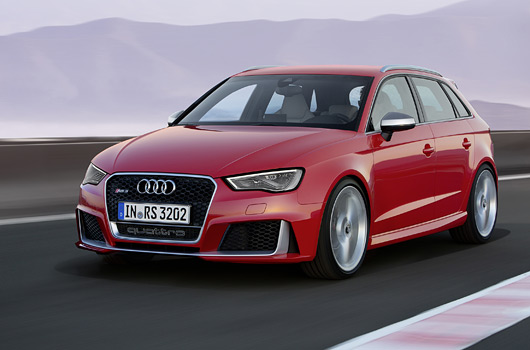
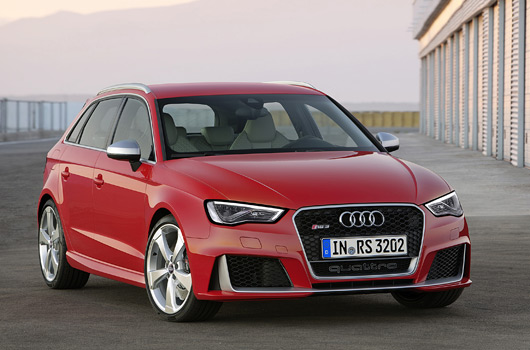
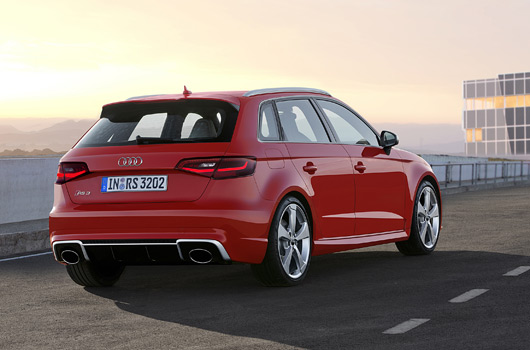
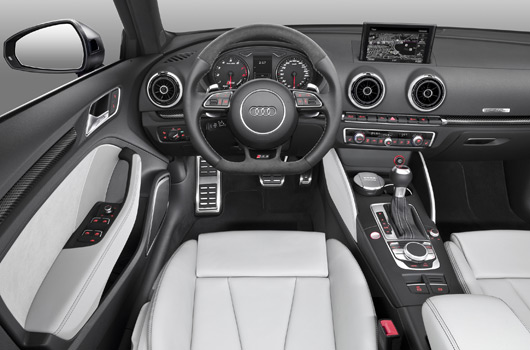
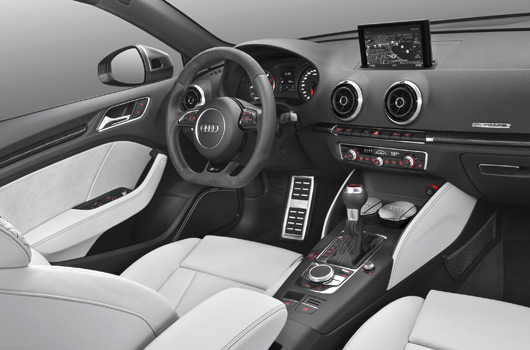
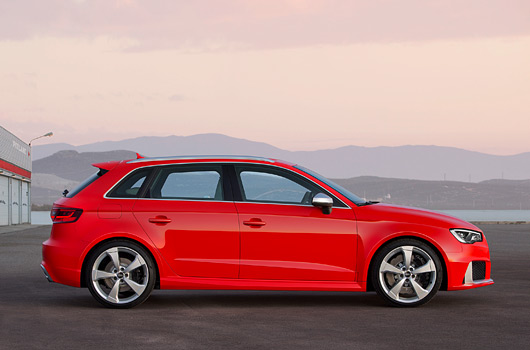
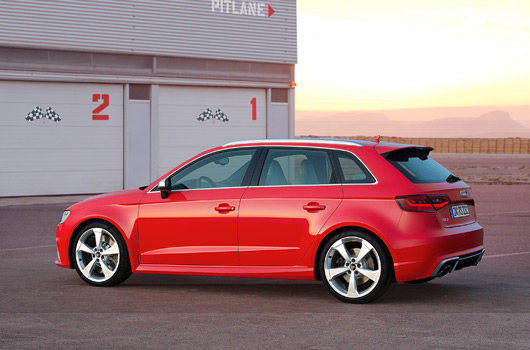
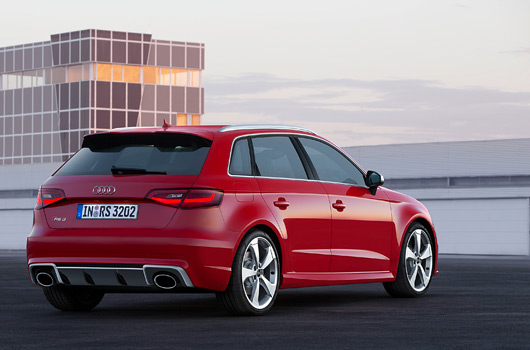
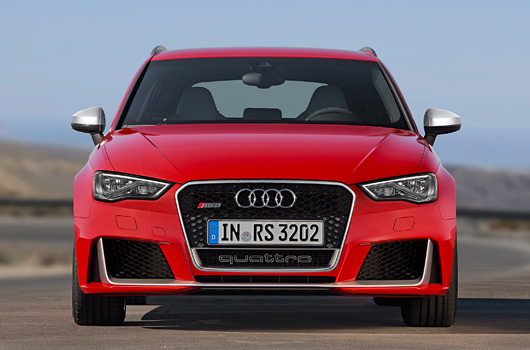
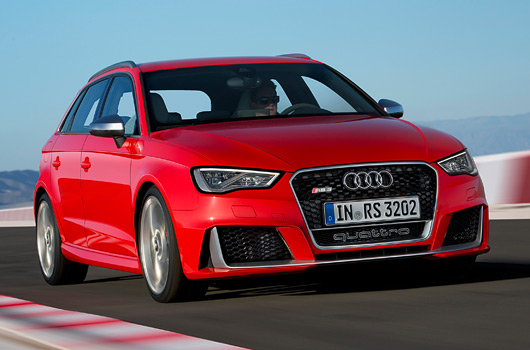
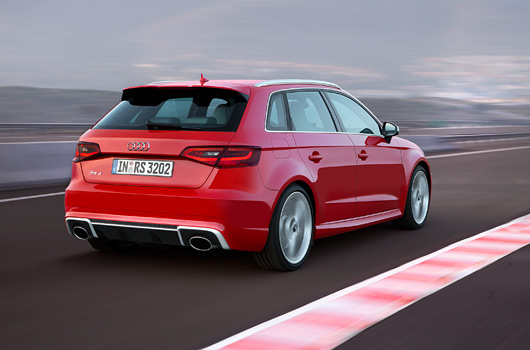
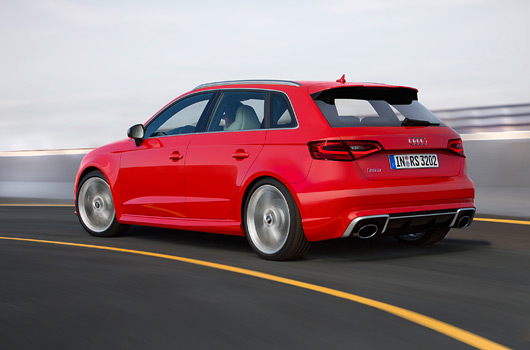
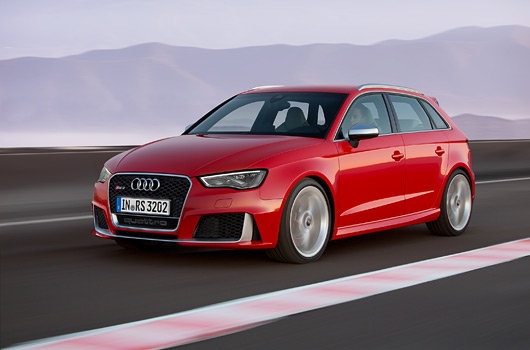
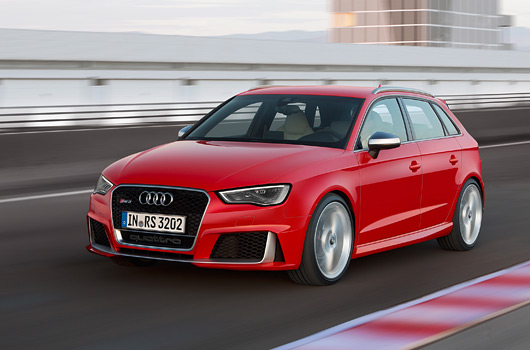
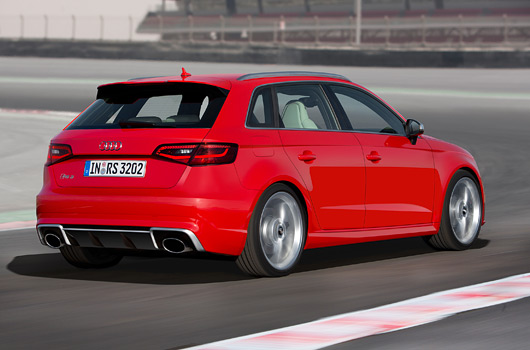
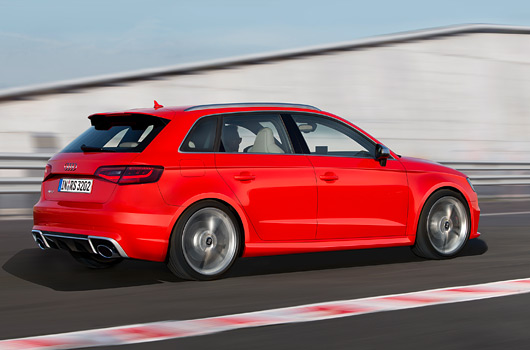
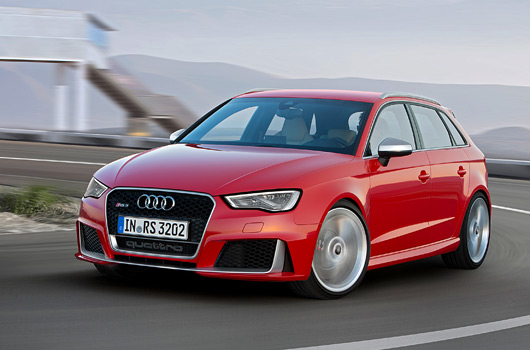
14 replies on “2015 Audi RS3 Sportback revealed”
Yes please!
Do want.
Is it just me or does S3 look better? Bring on M2!!!
It’s just you.
Yes please but in the sedan body. Any chance of that happening?
i hope the top gear review is true and this beast is tail happy
Like.
The ride height on that first pic looks great but surely too low for oem?
Only disappointment is 270kW, think they can safely push the five pot a bit closer to 300kW.
Have been eagerly anticipating this! But feel the design looks somewhat dated. Currently have an 8P S3 and will be keep a close eye on this as it nears aus launch
Le-sigh…
CTRL-F, $
If you have to ask the price, you can’t afford it…right?
[…] car should be available in Australia in late 2015 to AUSmotive, which gives you plenty of time to prepare. I hope you don’t think we’re […]
I’ll take one in the Sedan please.
looks like another transformer marvel design, why they dont add japanese element to the toy, and more screens with futuristic interface, more carbon to its formula1 steering wheel, and more chrome to make it luxury, then that would be another toy looking futuristic utopia transportation device, with rocket acceleration somewhere in a space without junctions and anything disturbing -and that would totally fit todays fashion of perfect spaceship device materialised, sadly even a track could be a problem for… P.S.
an Audi used to be even being sport but in shoes of everyday premium and sometimes only car to drive for the owner…
[…] “2015 Audi RS3 Sportback revealed”. AUSmotive.com. 2014-12-12. 4 Mayıs 2015 tarihinde kaynağından arÅŸivlendi. […]